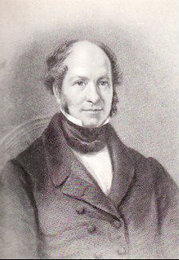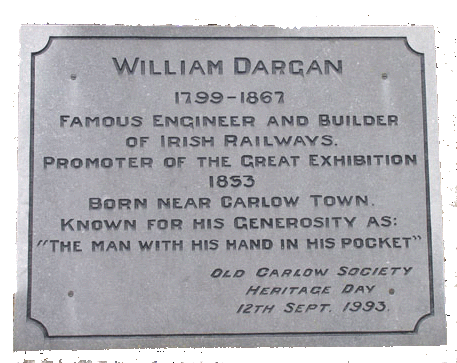(28th
February 1799 -
7th February1867)
William Dargan was a native of County Carlow the son of a small tenant farmer, he was an engineer
and is seen as the father of Irish railways. He was educated in
England and was later employed as surveyor by Telford on Holyhead
road in 1820 and was involved with George Stephenson in the Rocket
project. After returning to Ireland he became the engineer responsible
for the construction of Ireland's first railway, between Dublin
and Dunlahoire. Throughout his life he constructed some 800 miles
of track in Ireland and came to be known as 'The Father of Irish
Railways'.
of County Carlow the son of a small tenant farmer, he was an engineer
and is seen as the father of Irish railways. He was educated in
England and was later employed as surveyor by Telford on Holyhead
road in 1820 and was involved with George Stephenson in the Rocket
project. After returning to Ireland he became the engineer responsible
for the construction of Ireland's first railway, between Dublin
and Dunlahoire. Throughout his life he constructed some 800 miles
of track in Ireland and came to be known as 'The Father of Irish
Railways'.
Dargan's first contract in Ireland
was a mail coach road from Dublin to Howth harbour, next he constructed
an embankment on the river Shannon, near Limerick. His next project
was the Dublin to Kingstown (Dún Laoghaire) railway the first
in Ireland, the line opened on 17th December 1838. This was to be
the first of many lines designed and built by Dargan all over Ireland,
in all he was responsible for around 800 miles.
His talents were not confined
to the railways, he was also responsible for the construction of
the Ulster canal which connected Lough Neagh to Lough Erne, this
was built around 1841 at a cost of £231,000, he is remembered
in Belfast for his part in constructing part of the shipyard which
was to become Harland and Wolff, it is said Queens Island named
so after a visit from Queen Victoria was previously called Dargan's
Island.
William Dargan's contribution
to the Irish economy was considerable, it is estimated that between
the years of 1845 - 50 he paid out some £4 million pounds
in wages. He appears to have been a man who had the national interest
at heart, he had seen the prosperity the linen industry had brought
to Ulster and attempted to introduce flax growing to Cork. He built
flax mills in Dublin and bought a large farm at Kildinan, outside
Cork City where he experimented with flax growing, he offered to
supply local farmers with flax seeds and buy the crops at current
Belfast prices, few of the farmers took up his offer, fearing that
flax would deplete the fertility of the soil. This venture proved
to be a costly financial mistake.
Dargan was involved in many
other engineering projects throughout Ireland, such as the cut made
through Banbridge,
County Down, in 1834 to make it easier for the mail coaches to reach
the top of the town.
He was a member of the Royal
Dublin Society and was largely responsible for organizing and funding
the great exhibition held in 1853 which was opened by Queen Victoria,
The Queen visited him at his home Mount Anville on 29 August 1853
where she offered him a knighthood, which he politely refused.
He lived for a time in Mount
Anville House in Goatstown, County Dublin, he moved to Fitzwilliam
Square in Dublin, this must have been before 1851, an advertisement
for The Irish Sugar Beet Company in the Glasgow Herald 28 April
1851 listed his as a director and his address as Fitzwilliam Sq
Dublin. (We are indebted to John Morris for the Glasgow Herald information)
|
 of County Carlow the son of a small tenant farmer, he was an engineer
and is seen as the father of Irish railways. He was educated in
England and was later employed as surveyor by Telford on Holyhead
road in 1820 and was involved with George Stephenson in the Rocket
project. After returning to Ireland he became the engineer responsible
for the construction of Ireland's first railway, between Dublin
and Dunlahoire. Throughout his life he constructed some 800 miles
of track in Ireland and came to be known as 'The Father of Irish
Railways'.
of County Carlow the son of a small tenant farmer, he was an engineer
and is seen as the father of Irish railways. He was educated in
England and was later employed as surveyor by Telford on Holyhead
road in 1820 and was involved with George Stephenson in the Rocket
project. After returning to Ireland he became the engineer responsible
for the construction of Ireland's first railway, between Dublin
and Dunlahoire. Throughout his life he constructed some 800 miles
of track in Ireland and came to be known as 'The Father of Irish
Railways'.